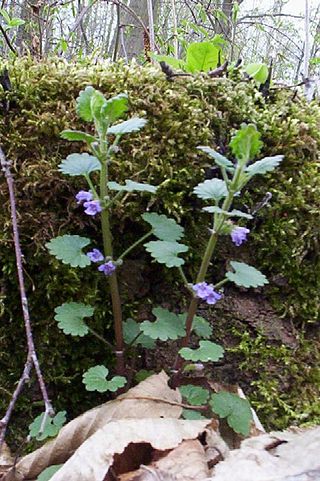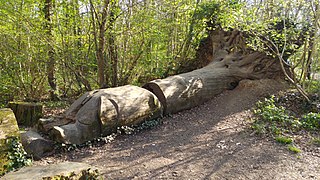
Glechoma hederacea is an aromatic, perennial, evergreen creeper of the mint family Lamiaceae. It is commonly known as ground-ivy, gill-over-the-ground, creeping charlie, alehoof, tunhoof, catsfoot, field balm, and run-away-robin. It is also sometimes known as creeping jenny, but that name more commonly refers to Lysimachia nummularia. It is used as a salad green in many countries. European settlers carried it around the world, and it has become a well-established introduced and naturalized plant in a wide variety of localities. It is also considered an aggressive invasive weed of woodlands and lawns in some parts of North America. In the absence of any biological control, research conducted by the USDA herbicides are relied upon particularly for woodland ecosystems. The plant's extensive root system makes it difficult to eradicate by hand-pulling.

Glechoma is a genus of flowering plants in the mint family, Lamiaceae, first described for modern science in 1753. It is distributed in northern Asia and Europe with a center of diversity in Asia, especially China. One species is naturalized in New Zealand and in North America.
NVC community W8 is one of the woodland communities in the British National Vegetation Classification system. It is one of the six communities falling in the "mixed deciduous and oak/birch woodlands" group.
Creeping charlie is a common name for several species of flowering plants:

Coleophora albitarsella is a moth of the family Coleophoridae. It is found in most of Europe, but has not been recorded from Ireland and Greece.

Coleophora ochripennella is a species of moth from the family Coleophoridae. It is found from Germany and Poland to the Pyrenees, Italy and Greece.
Jin Qian Cao or Jinqiancao is a term used in traditional Chinese herbal medicine. It can refer to several different herbal species, generally identified by their native regions. The most common of these in the Chinese trade, listed in the Pharmacopoeia of the People's Republic of China, is Lysimachia christinae, but in the West Desmodium and Glechoma may be more commonly encountered.

Nematopogon schwarziellus is a moth of the Adelidae family. It is found in almost all of Europe, except Portugal, Slovenia, Croatia, Greece and Ukraine.
Hypenolobosa glechoma is a species of moth of the family Tortricidae. It is found in Chihuahua, Mexico.

Saperdini is a tribe of longhorn beetles of the subfamily Lamiinae.
Heteroglenea is a genus of longhorn beetles of the subfamily Lamiinae, containing the following species:

Mentheae is the largest tribe of plants in the family Lamiaceae. It includes herbs such as sage, hyssop, mint, bee balm and thyme.

Lodge Wood and Sandford Mill is a 2.3-hectare (5.7-acre) biological Site of Special Scientific Interest east of Woodley in Berkshire.
Heteroglenea gemella is a species of beetle in the family Cerambycidae. It was described by Lin and Yang in 2009. It is known from Nepal.
Heteroglenea bastiensis is a species of beetle in the family Cerambycidae. It was described by Stephan von Breuning in 1956. It is known from India.
Heteroglenea fissilis is a species of beetle in the family Cerambycidae. It was described by Stephan von Breuning in 1953. It is known from Myanmar, India, Bangladesh, Laos, China, and Thailand. It feeds on Dialium cochinchinense.
Heteroglenea mediodiscoprolongata is a species of beetle in the family Cerambycidae. It was described by Stephan von Breuning in 1964, originally under the genus Glenea. It is known from Laos, China, and Thailand.
Heteroglenea nigromaculata is a species of beetle in the family Cerambycidae. It was described by James Thomson in 1865. It is known from Laos, China, Thailand, Myanmar, Cambodia, Vietnam, Philippines and India. It feeds on Streblus asper.

Clayfield Copse is a local nature reserve on the northern edge of the suburb of Caversham in Reading, UK. The site is 8.65 hectares in size and is a natural open space consisting of fields, wild flower meadow and native woodlands adjoining the Oxfordshire countryside. Some of the woodland is being actively managed as hazel coppice, and traditional dead hedging defines some of the ancient woodland areas. The site is the only outcrop of London Clay north of the River Thames in Reading and makes up the southern tip of the Chiltern Hills. The nature reserve is under the management of the Reading Borough Council.







